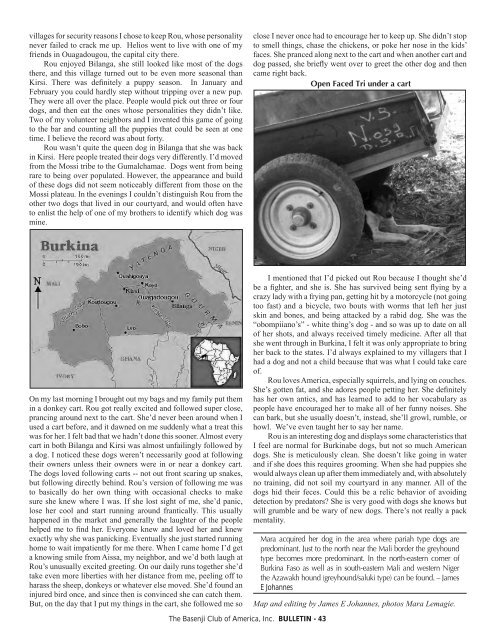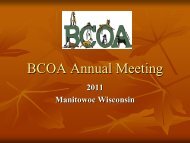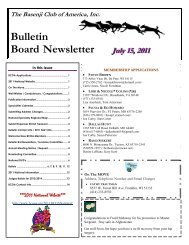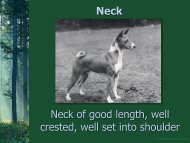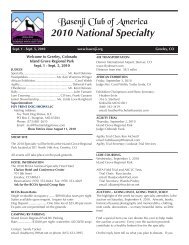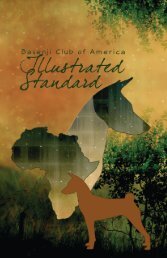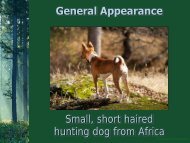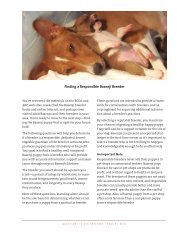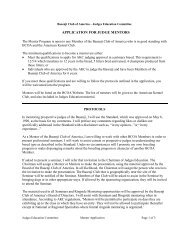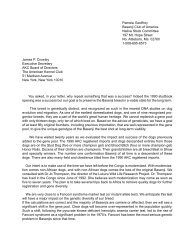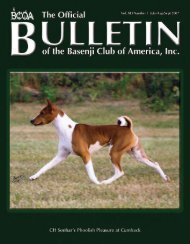Burkina Faso DogsBy Mara Lemagie<strong>the</strong> start <strong>of</strong> my Peace Corps service in <strong>the</strong> town <strong>of</strong>AT Kirsi in Burkina Faso one <strong>of</strong> <strong>the</strong> first things I decidedto do was to get a dog. I asked everyone around town in my basicMoore (<strong>the</strong> local language) and was told that it was not yet <strong>the</strong>correct season. I’d never thought <strong>of</strong> it in terms <strong>of</strong> harvest, but dogsare definitely born during <strong>the</strong> jardinage - <strong>the</strong> season just after <strong>the</strong>main harvest when veggies are grown if <strong>the</strong>re is a barrage or anearby source <strong>of</strong> water. They told me to wait until October, butthat December-<strong>January</strong> was really <strong>the</strong> time to get a pup. Sincemy job was teaching and classes began in October this was notgoing to work for me. I even asked <strong>the</strong> guy, who brought in biisap-- a frozen tea -- from ano<strong>the</strong>r town to ask around in his village.However, several people wanted to <strong>of</strong>fer me monkeys instead <strong>of</strong>puppies. I would go for bike rides and essentially harass <strong>the</strong> peopleI see if <strong>the</strong>y knew <strong>of</strong> any litters. There was one puppy I saw thatwas following a cart. I asked <strong>the</strong> women about it, and she said thatit had always been a smaller dog – so not a puppy.One day I finally got word <strong>of</strong> a litter, but all <strong>of</strong> <strong>the</strong> maleshad already been taken. I followed a guy towards <strong>the</strong> river to hisfamily’s concession. There I saw about ten puppies running aroundand hiding under <strong>the</strong> empty granaries. Three <strong>of</strong> <strong>the</strong>m ran up tome and were very friendly. There was one black female puppy,<strong>the</strong> unique one <strong>the</strong> owners said, that wouldn’t come to me. Thepuppies were about three weeks old and tiny. I was never ableto figure out how many litters <strong>the</strong>re were, possibly two. One <strong>of</strong><strong>the</strong> momma dogs walked over and some <strong>of</strong> <strong>the</strong> pups jumped upand ran to her while <strong>the</strong> rest stayed languidly behind. The mo<strong>the</strong>rwas not interested in feeding <strong>the</strong>m, and it was apparent that <strong>the</strong>rewas a serious caloric deficit amongst all <strong>of</strong> <strong>the</strong> dogs present. Theblack one persisted in her attempts to get milk from <strong>the</strong> mo<strong>the</strong>r.Knowing that many volunteers lost <strong>the</strong>ir dogs to health relatedissues, I decided to go with <strong>the</strong> fighter.I tried to convince <strong>the</strong> family to hold her for me and let herdrink her mo<strong>the</strong>r’s milk for a couple more weeks, but <strong>the</strong>y said<strong>the</strong>y would just give <strong>the</strong> puppy to <strong>the</strong> next person. I gave <strong>the</strong>m adollar which I definitely over paid according to my village mom.She scolded <strong>the</strong> people for ripping me <strong>of</strong>f. The man picked up <strong>the</strong>black puppy with white on her face, tail, and feet, and we rode backto <strong>the</strong> village. I was told that all dogs were just simply called baaga,meaning dog. I wanted to be a little more creative and named mydog Roumsii (Room-sea), which meant mosquitoes. I later learnedthat it also means animals; so much for not being generic.Roumsii definitely had a personality,and went everywhere with me. When Ifirst got her I was feeding her whateverI could think <strong>of</strong> -- beans, milk, andsardines. She was so malnourished thatafter a small meal her tummy would bloatand almost drag against <strong>the</strong> ground. One<strong>of</strong> <strong>the</strong> villagers said I’d better not feed heranymore or else she would die. “A sas dityeeda, a nan kiime.”At first I carried Rou around in mybackpack, and <strong>the</strong>n when she was oldershe followed as I rode my bicycle. SheRoumsiicould last for about ten miles at full speed before she got tired.She’d let me know by trying to run just in front <strong>of</strong> <strong>the</strong> bicycle soI’d have to slow down, and <strong>the</strong>n she’d stop. After this happened Iwould pick her up and put her in a basket that was attached to <strong>the</strong>back <strong>of</strong> <strong>the</strong> bike. Roumsii would lie down with her tongue lollingin <strong>the</strong> wind and smiling at <strong>the</strong> shocked people as we rolled past. I’dattempted to train her using a leash, but it was so ridiculous becauseshe followed me more or less in her own style that everyone justlaughed. Later, I noticed o<strong>the</strong>r people finding random cloth scrapsand trying to walk <strong>the</strong>ir dogs on leashes.When Roumsii was six months old, she went into heat. I suspectedthat something was about to happen, but didn’t realize what wasgoing on until one evening while we were at school coaching <strong>the</strong>girls’ soccer team one <strong>of</strong> <strong>the</strong> girls noticed Rou in <strong>the</strong> bushes with<strong>the</strong> Director’s dog. It was wedding time! The girls started jokingabout it, and since we were talking about Rou it was okay for <strong>the</strong>mto mention condoms, and monogamy, and ask me questions abou<strong>the</strong>r behavior. They decided that <strong>the</strong> dogs should get married, butthat <strong>the</strong>y needed biisap in order for it to be an <strong>of</strong>ficial wedding. Just<strong>the</strong>n <strong>the</strong> biisap man rolled past, on his way home. It was <strong>of</strong>ficial.For <strong>the</strong> next couple <strong>of</strong> weeks I carried a large stick with mewherever we went. Mostly I left Rou locked up at home, andprepared myself with rocks so that I could get into my courtyardwithout too much difficulty. This was why all <strong>of</strong> <strong>the</strong> male dogs hadall been taken when I’d gotten Rou as a puppy – a swarm <strong>of</strong> maledogs was not fun to deal with.Rou had a litter <strong>of</strong> six, and <strong>the</strong> villagers loved asking me aboutit. They all wanted one <strong>of</strong> <strong>the</strong> pups. She had four males and tw<strong>of</strong>emales. I ended up giving two puppies to o<strong>the</strong>r volunteers, andthree o<strong>the</strong>r pups to people in my village, one to each <strong>of</strong> my “moms”and one to <strong>the</strong> Prefet, or government <strong>of</strong>ficial, in <strong>the</strong> village. Hebought me a beer in exchange for <strong>the</strong> pup when I’d refused to lethim pay me. Later, when <strong>the</strong> pup died he’d told me that it wasbecause he hadn’t properly paid me for her.I kept one <strong>of</strong> <strong>the</strong> males, and named him Helios. He wasgorgeous and s<strong>of</strong>t and incredibly friendly. When my family camefrom <strong>the</strong> states to visit, <strong>the</strong>y fell in love with him. Rou was a bitmore stand<strong>of</strong>fish and enjoyed stirring up trouble. Helios, however,was lazy and was willing to let my sisters carry him around like alittle baby. Rou was always careful to defecate far, far away from<strong>the</strong> house, trails, roads etc. However, Helios decided that poopingin my latrine was acceptable – he was lazy. When I had to switchHeliosThe <strong>Basenji</strong> <strong>Club</strong> <strong>of</strong> America, Inc. BULLETIN - 42
villages for security reasons I chose to keep Rou, whose personalitynever failed to crack me up. Helios went to live with one <strong>of</strong> myfriends in Ouagadougou, <strong>the</strong> capital city <strong>the</strong>re.Rou enjoyed Bilanga, she still looked like most <strong>of</strong> <strong>the</strong> dogs<strong>the</strong>re, and this village turned out to be even more seasonal thanKirsi. There was definitely a puppy season. In <strong>January</strong> and<strong>February</strong> you could hardly step without tripping over a new pup.They were all over <strong>the</strong> place. People would pick out three or fourdogs, and <strong>the</strong>n eat <strong>the</strong> ones whose personalities <strong>the</strong>y didn’t like.Two <strong>of</strong> my volunteer neighbors and I invented this game <strong>of</strong> goingto <strong>the</strong> bar and counting all <strong>the</strong> puppies that could be seen at onetime. I believe <strong>the</strong> record was about forty.Rou wasn’t quite <strong>the</strong> queen dog in Bilanga that she was backin Kirsi. Here people treated <strong>the</strong>ir dogs very differently. I’d movedfrom <strong>the</strong> Mossi tribe to <strong>the</strong> Gumalchamae. Dogs went from beingrare to being over populated. However, <strong>the</strong> appearance and build<strong>of</strong> <strong>the</strong>se dogs did not seem noticeably different from those on <strong>the</strong>Mossi plateau. In <strong>the</strong> evenings I couldn’t distinguish Rou from <strong>the</strong>o<strong>the</strong>r two dogs that lived in our courtyard, and would <strong>of</strong>ten haveto enlist <strong>the</strong> help <strong>of</strong> one <strong>of</strong> my bro<strong>the</strong>rs to identify which dog wasmine.close I never once had to encourage her to keep up. She didn’t stopto smell things, chase <strong>the</strong> chickens, or poke her nose in <strong>the</strong> kids’faces. She pranced along next to <strong>the</strong> cart and when ano<strong>the</strong>r cart anddog passed, she briefly went over to greet <strong>the</strong> o<strong>the</strong>r dog and <strong>the</strong>ncame right back.Open Faced Tri under a cartOn my last morning I brought out my bags and my family put <strong>the</strong>min a donkey cart. Rou got really excited and followed super close,prancing around next to <strong>the</strong> cart. She’d never been around when Iused a cart before, and it dawned on me suddenly what a treat thiswas for her. I felt bad that we hadn’t done this sooner. Almost everycart in both Bilanga and Kirsi was almost unfailingly followed bya dog. I noticed <strong>the</strong>se dogs weren’t necessarily good at following<strong>the</strong>ir owners unless <strong>the</strong>ir owners were in or near a donkey cart.The dogs loved following carts -- not out front scaring up snakes,but following directly behind. Rou’s version <strong>of</strong> following me wasto basically do her own thing with occasional checks to makesure she knew where I was. If she lost sight <strong>of</strong> me, she’d panic,lose her cool and start running around frantically. This usuallyhappened in <strong>the</strong> market and generally <strong>the</strong> laughter <strong>of</strong> <strong>the</strong> peoplehelped me to find her. Everyone knew and loved her and knewexactly why she was panicking. Eventually she just started runninghome to wait impatiently for me <strong>the</strong>re. When I came home I’d geta knowing smile from Aissa, my neighbor, and we’d both laugh atRou’s unusually excited greeting. On our daily runs toge<strong>the</strong>r she’dtake even more liberties with her distance from me, peeling <strong>of</strong>f toharass <strong>the</strong> sheep, donkeys or whatever else moved. She’d found aninjured bird once, and since <strong>the</strong>n is convinced she can catch <strong>the</strong>m.But, on <strong>the</strong> day that I put my things in <strong>the</strong> cart, she followed me soI mentioned that I’d picked out Rou because I thought she’dbe a fighter, and she is. She has survived being sent flying by acrazy lady with a frying pan, getting hit by a motorcycle (not goingtoo fast) and a bicycle, two bouts with worms that left her justskin and bones, and being attacked by a rabid dog. She was <strong>the</strong>“obompiiano’s” - white thing’s dog - and so was up to date on all<strong>of</strong> her shots, and always received timely medicine. After all thatshe went through in Burkina, I felt it was only appropriate to bringher back to <strong>the</strong> states. I’d always explained to my villagers that Ihad a dog and not a child because that was what I could take care<strong>of</strong>.Rou loves America, especially squirrels, and lying on couches.She’s gotten fat, and she adores people petting her. She definitelyhas her own antics, and has learned to add to her vocabulary aspeople have encouraged her to make all <strong>of</strong> her funny noises. Shecan bark, but she usually doesn’t, instead, she’ll growl, rumble, orhowl. We’ve even taught her to say her name.Rou is an interesting dog and displays some characteristics thatI feel are normal for Burkinabe dogs, but not so much Americandogs. She is meticulously clean. She doesn’t like going in waterand if she does this requires grooming. When she had puppies shewould always clean up after <strong>the</strong>m immediately and, with absolutelyno training, did not soil my courtyard in any manner. All <strong>of</strong> <strong>the</strong>dogs hid <strong>the</strong>ir feces. Could this be a relic behavior <strong>of</strong> avoidingdetection by predators? She is very good with dogs she knows butwill grumble and be wary <strong>of</strong> new dogs. There’s not really a packmentality.Mara acquired her dog in <strong>the</strong> area where pariah type dogs arepredominant. Just to <strong>the</strong> north near <strong>the</strong> Mali border <strong>the</strong> greyhoundtype becomes more predominant. In <strong>the</strong> north-eastern corner <strong>of</strong>Burkina Faso as well as in south-eastern Mali and western Niger<strong>the</strong> Azawakh hound (greyhound/saluki type) can be found. – JamesE JohannesMap and editing by James E Johannes, photos Mara Lemagie.The <strong>Basenji</strong> <strong>Club</strong> <strong>of</strong> America, Inc. BULLETIN - 43


